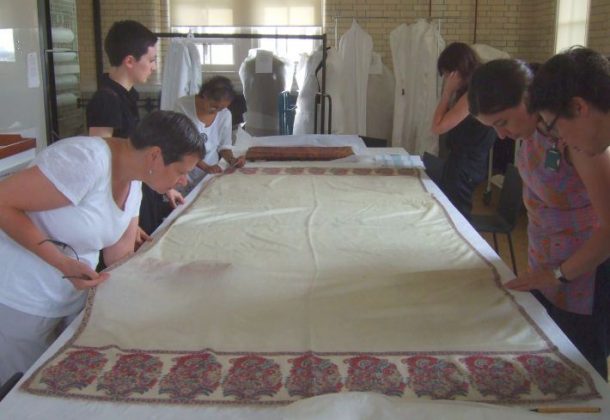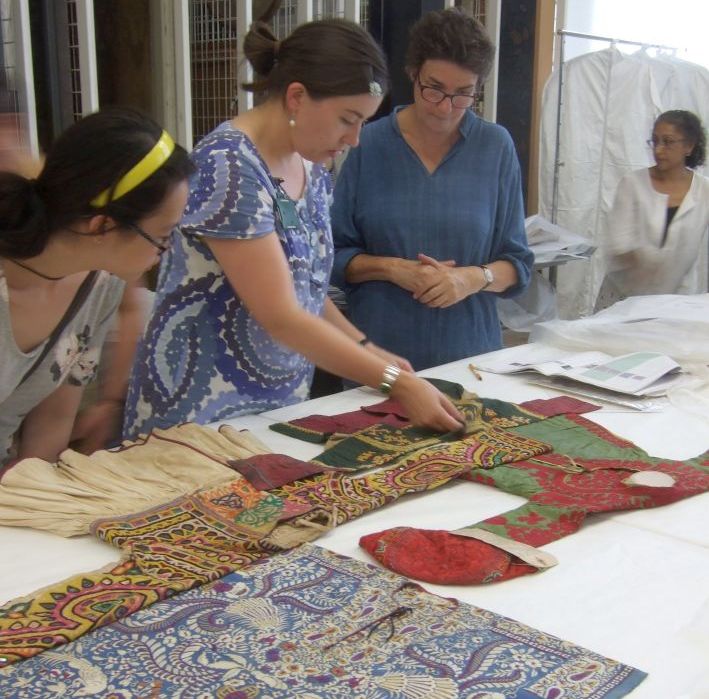The last few weeks mark a particularly exciting moment in the development of any exhibition: we have appointed an exhibition designer. Gitta Geschwendtner and her team of 3d, 2d and lighting designers will be drawing together spaces, surfaces, light and graphics to support and reveal the stories hiding in the textiles. This is when things start to become tangible: when an exhibition begins its transition from an idea, existent only in drifts of paper research and photography, to a real, physical thing.

Exhibitions appear at the fragile moment of coincidence between the vision of a curator, the objectives of an institution and the anticipated (and hoped for) interest of a public. They are also shaped by the fragile circumstances of limited budgets, resources, and time. As Senior Exhibitions Coordinator I support the Exhibitions team to navigate these circumstances: to help the Curators and Designers draw out the strongest stories in the exhibition, to create spaces for team members to think, meet, and make the best of their own ideas with the resources available. Sometimes this means being the bad guys: bringing home the unwelcome realities of a lack of space or money.
One of the greatest challenges we face for The Fabric of India is what to include and what to leave out. At the V&A we are lucky, we have one of the finest collections of Indian Textiles (sadly few historic textiles have survived the humid climates found in India) and this exhibition grows out of the culmination of a career dedicated researching Indian Textiles. Rosemary Crill is a world leading expert in Indian Textiles and has been mentally ‘collecting’ for this exhibition for decades. This of course means we are spoiled for choice and currently have enough objects on our list to fill Hyde Park, let alone the V&A.


It is the role of myself and Olivia (Exhibition Coordinator) to work with the curators to crystallise the story, and sometimes to play devil’s advocate: to ask what happens if we omit this object, or that. This was all going well until we headed off to the Clothworkers’ Centre at Blythe House to look at the textiles for real. Here we both weaken. Everything is so beautiful, each object is fascinating; even the palest of subtle cottons that, in the back of our mind, we know will be nearly invisible behind glass. Outside of museum hours I do a lot of making, particularly with Indian textiles, and so am easily distracted from my documentary and editorial purposes by the fascinating technical details of the objects and start photographing weaves, sleeve constructions, and pleating techniques that I’ve not seen before.

The photography becomes surrogate ownership: we want everything and we see why Rosemary and Divia want everything too. Quantity and variety is a big part of the story of Indian textiles from early times until today. Go to a sari bazar in India and your first impressions is of plethora, rainbows of colour, dazzling decorations and patterns layered upon patterns. Even in these days of mechanical production you are unlikely to find two the same. So we return to the museum with a challenge: How to tell this story or vastness in variety with only 200 objects? How to communicate overwhelming quantity and variety without overwhelming our visitors? We are hoping that our designers will help us with the answers.

With my particular fascination for the Northern Indian 18thC and 19thC hand knitted items I cannot wait to see the exquisite workmanship on the gloves or stockings.
Thoroughly enjoying reading your blog. Please do take a look at what we do – Indian crafts study trips on Facebook and website attached above. It is wonderful to see these exquisite skills being shared with the World.
Good information. Thanks for sharing..